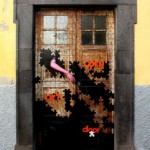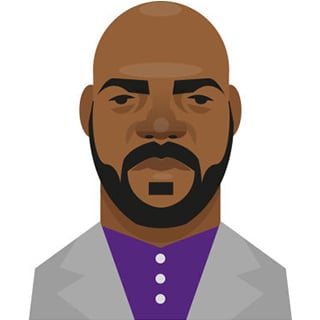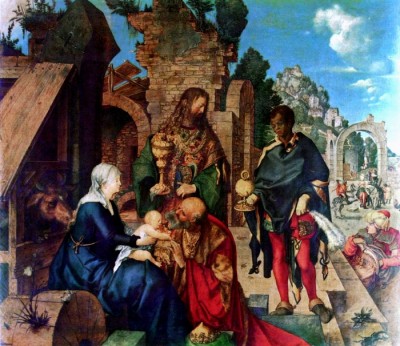 Moving slowly, they emerge from the darkness of human imagination, first as the rippling of shadows, then forming into majestic selves as the bright star leads them into the light of the Child. Everything about them is quiet. The silence of camel hooves in sand. Their beautiful cloaks, muffling human sounds. They do not speak. They give, they dream, they leave.
Moving slowly, they emerge from the darkness of human imagination, first as the rippling of shadows, then forming into majestic selves as the bright star leads them into the light of the Child. Everything about them is quiet. The silence of camel hooves in sand. Their beautiful cloaks, muffling human sounds. They do not speak. They give, they dream, they leave.
Going home by another way, they remain with us as wonder. We carry them all our days, for home is the place we spend our lives seeking, on unknown roads.
Luke does not mention them. For Luke, who wrote wonder after wonder into his gospel, there were no kings at Christ’s birth, no special star, only ordinary shepherds from Bethlehem who briefly saw the light of angels there.
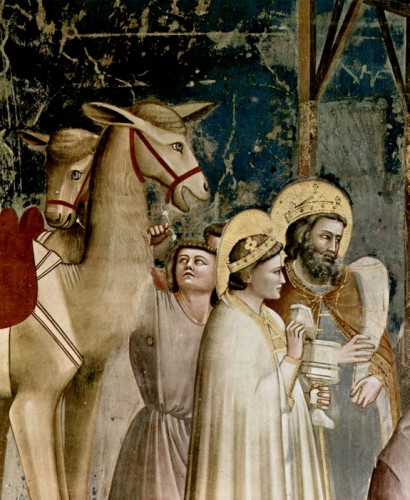 Matthew, a rabbinic writer given to explaining away the least bit of miraculous detail, a teacher who replaces imagination with instruction on every page, gives us this extraordinary tale, so different from the rest of his gospel. Why does he bring it forward? Is it the kings, the gifts, the star – or the murders – that he wants us to remember?
Matthew, a rabbinic writer given to explaining away the least bit of miraculous detail, a teacher who replaces imagination with instruction on every page, gives us this extraordinary tale, so different from the rest of his gospel. Why does he bring it forward? Is it the kings, the gifts, the star – or the murders – that he wants us to remember?
No one else mentions these Wise Men. Luke writes of Mary, her determination, her words, her conversation with an angel, her journeys, her lying down in straw because there was no room in the inn.
Matthew has none of this at all. Mary does not speak. Joseph is the hero here. He alone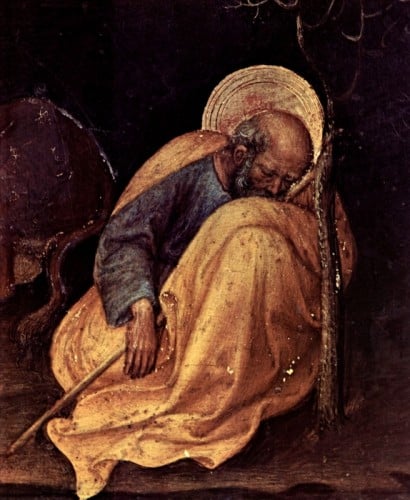 encounters an angel, in a dream, determines to take Mary to Bethlehem and marry her, then again dreams, this time of danger, and rushes her and the child to Egypt, in the nick of time.
encounters an angel, in a dream, determines to take Mary to Bethlehem and marry her, then again dreams, this time of danger, and rushes her and the child to Egypt, in the nick of time.
Matthew’s numberless kings arrive without camels, in silence. They shine the light of their wisdom on Herod and share their only conversation with him. In his palace and in his conversation they find no signs at all of wisdom, divinity, purpose, or the glory they are seeking. Quite the opposite, in fact: they turn down his requests to accompany them, and refuse to give him information.
Devoid of talent, ignorant of his own traditions, and without God’s anointing, Herod uses dark arts to keep his throne: terror; savagery and secrets; the murder of children, for which he is remembered still. This birth story is grisly, shocking.
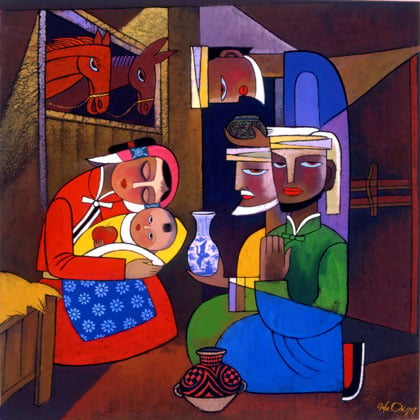 Matthew does not shrink from telling us that the coming as well as the going of God from this world are shrouded in violence, intrigue and destruction, and require our courage, risk, and following of small and unexpected lights to guide our way.
Matthew does not shrink from telling us that the coming as well as the going of God from this world are shrouded in violence, intrigue and destruction, and require our courage, risk, and following of small and unexpected lights to guide our way.
Yet Luke’s more tranquil story of this birth has in it Mary’s prophetic forecast, that God will scatter the proud in the imagination of their hearts, pull the mighty from their thrones and send the rich empty away – all the things that Herod fears. As coda, the prophet Simeon says, This Child is set for the fall and rising of many.
A colleague* two towns away has written that the little girl who was the Star in her church pageant, who led the Wise Men down the aisle, whose mother then lifted her up so she could shine above the manger, has been deported by the INS.
Herod is still sending centurions to trample through small towns in the name of the public good. The sleeping populace yawns in unconcern, buys dark weapons for itself in epic numbers and delusions of similar proportion, and goes to church on Christmas Eve, believing this story is safe for children, a comfort on a starry winter night.
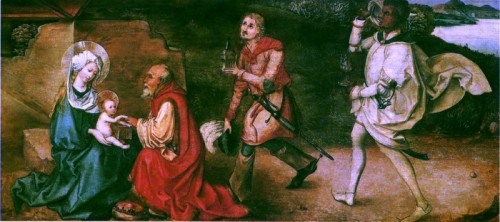 The story, though, has the true power of sacred tales: it is Eternal. It is, and always will be happening now. And the children who live it, who live through it, who are lifted up within it and see its light, are the ones whose lives are anointed by it, who will become its light. When grown, it is they who will speak to us about God and Herod, they who will know whose throne is real and whose is to be torn down, they who have heard what the Wise Men knew and what they really gave, and where in the world they went, after Bethlehem.
The story, though, has the true power of sacred tales: it is Eternal. It is, and always will be happening now. And the children who live it, who live through it, who are lifted up within it and see its light, are the ones whose lives are anointed by it, who will become its light. When grown, it is they who will speak to us about God and Herod, they who will know whose throne is real and whose is to be torn down, they who have heard what the Wise Men knew and what they really gave, and where in the world they went, after Bethlehem.
According to T.S. Eliot, the Magi took what they learned at the crib home to ponder:
. . . were we led all that way for
Birth or Death? There was a Birth, certainly,
We had evidence and no doubt. I had seen birth and death,
But had thought they were different; this Birth was
Hard and bitter agony for us, like Death, our death.
We returned to our places, these Kingdoms,
But no longer at ease here, in the old dispensation,
With an alien people clutching their gods.
Christmas closes at the cliff of these questions. We enter a winter’s season of epiphanies in which to seek their meaning.
_________________
*Maren Tirabassi, Gifts in Open Hands: http://giftsinopenhands.wordpress.com/2012/12/29/791/
Illustrations:
1. Adoration of the Christ Child by theThree Wise Men. 1504. Durer, Albrecht. 1504.-Galleria degli Uffizi, Florence, Italy. Vanderbilt Divinity School Library, Art in the Christian Tradition
2. Magi by Giotto di Bonadone, Vanderbilt Divinity School Library, Art in the Christian Tradition
3. Detail of Joseph by Gentile da Fabriano. Vanderbilt Divinity School Library, Art in the Christian Tradition
4. Magi by He Qi, Nanqing, China. Vanderbilt Divinity School Library, Art in the Christian Tradition
5. Magi by Albrecht Durer, Vanderbilt Divinity School Library, Art in the Christian Tradition.



